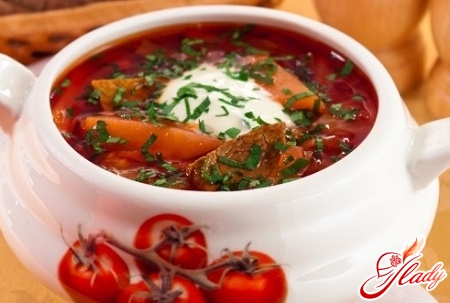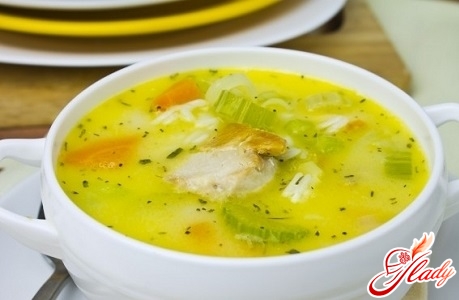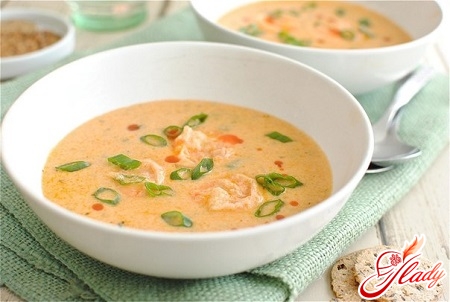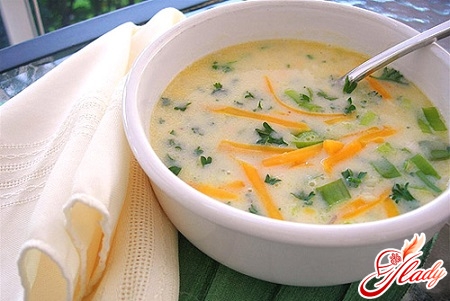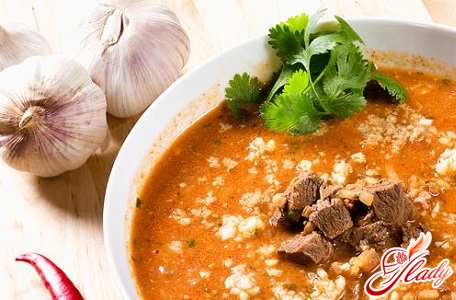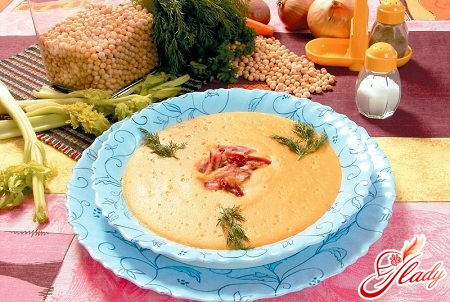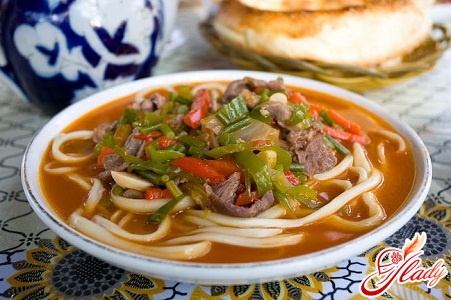 Have you ever tried lagman?Surely you have enjoyed the delicious aroma of fried meat, which is accompanied by the fragrance of fresh parsley and celery and the tart smell of cumin and coriander; and the delicious amber circles of fat floating in the broth and thin noodles in harmony with tender vegetables harmoniously complement the taste and aroma of meat. Lagman is one of the most favorite dishes of admirers of "real man's food". This is an oriental dish consisting of a special type of noodles (lagman itself) and a gravy of meat and vegetables; these two components of the dish are cooked separately, and before serving they are combined in a warmed kasa - an Uzbek plate. Almost every country in the world has a national dish reminiscent of lagman: noodles and gravy of meat and vegetables cooked separately but served together; noodles in each country are different - thick or thin, cut or pulled, rice or wheat. The ingredients added to the gravy also vary. In Korea, for example, they use fresh cucumber. Red vinegar, katyk, a mixture of different peppers, cumin and saffron are added to Tatar lagman. The recipe for Siberian lagman differs in that it contains minced meat and pickled cucumber. In Malaysia, they prepare "laksa", it is made with chicken and coconut milk. And in Latin America, instead of meat, they put fish and call this dish "chupin". In this article, you will find all the necessary information about lagman: a recipe and a photo of the finished dish.
Have you ever tried lagman?Surely you have enjoyed the delicious aroma of fried meat, which is accompanied by the fragrance of fresh parsley and celery and the tart smell of cumin and coriander; and the delicious amber circles of fat floating in the broth and thin noodles in harmony with tender vegetables harmoniously complement the taste and aroma of meat. Lagman is one of the most favorite dishes of admirers of "real man's food". This is an oriental dish consisting of a special type of noodles (lagman itself) and a gravy of meat and vegetables; these two components of the dish are cooked separately, and before serving they are combined in a warmed kasa - an Uzbek plate. Almost every country in the world has a national dish reminiscent of lagman: noodles and gravy of meat and vegetables cooked separately but served together; noodles in each country are different - thick or thin, cut or pulled, rice or wheat. The ingredients added to the gravy also vary. In Korea, for example, they use fresh cucumber. Red vinegar, katyk, a mixture of different peppers, cumin and saffron are added to Tatar lagman. The recipe for Siberian lagman differs in that it contains minced meat and pickled cucumber. In Malaysia, they prepare "laksa", it is made with chicken and coconut milk. And in Latin America, instead of meat, they put fish and call this dish "chupin". In this article, you will find all the necessary information about lagman: a recipe and a photo of the finished dish.
The main components and ingredients of Lagman
To make a real lagman, here is the recipeThe preparation must be quite precise. For lagman, vaja (there are other names for it - kayla, brine) and chuzma are prepared. Vaja is a gravy that is cooked in a cauldron. The taste of vaja should not distract the eater's attention; it is very important that all the ingredients of lagman harmonize with each other as much as possible. For Uyghur versions of the dish, meat and vegetables are fried over high heat so that the vegetables crunch slightly in the finished dish. Other recipes involve stewing vegetables over medium heat until fully cooked; vegetables are considered ready only when they are completely soft. Lamb is most often used for lagman, but beef is also allowed. Meat is cut in different ways: in the Uyghur style, meat is cut into long slices, in the Uzbek style - into cubes approximately 2x2 centimeters in size. In teahouses, meat is fried in large pieces - 100-150 grams. This way the meat tastes richer. At the end of cooking, it is taken out, finely chopped and added directly to the plate. The set of vegetables for this dish varies depending on the season. The obligatory ingredients are tomatoes, bell peppers, juSai (if necessary, it can be replaced with garlic shoots or wild garlic), onions. The Tashkent variation always includes radish (or daikon, or radish). A Uyghur cook never uses potatoes for this dish; Uzbeks add them almost always. Other vegetables are taken at will: cabbage, carrots, eggplants, turnips, green beans, beets. Before you start stewing vaja, all its components are first fried in either fat tail fat, or vegetable or ghee. The meat is always added first, then the onion, then the rest of the vegetables - in such a sequence that they do not end up overcooked. In order for vaja to be as close to its traditional appearance as possible, it is necessary to achieve a rich color of the prepared dish. To do this, the onion must be fried until golden brown before adding to vaja, and in addition to tomatoes, tomato paste can be added. Spices are added in each region in its own way: the Uyghurs add classic Chinese seasonings, basil is a must in Tashkent, Dungan lagman is seasoned with cumin, coriander and star anise (a little, it is very specific). As we have already mentioned, the second component of the dish is chuzma. This is a special elongated noodle. If you do not live in Central Asia, you are unlikely to be able to buy ready-made chuzma. If you really want to cook this chuzma dish, most likely, you will have to do it yourself. It is not difficult at all. An experienced housewife can make lagman in about 15 minutes. Those who are doing this for the first time will, of course, have to work hard, but still it is not that labor-intensive. As an addition to this fabulous oriental soup, they serve Sai (a salad of fried eggplants, meat and pepper), lazhsan/laza/lan-chang (red pepper with garlic, poured with boiling oil), fried juSai, various sauces: green onion, celery, green beans and others.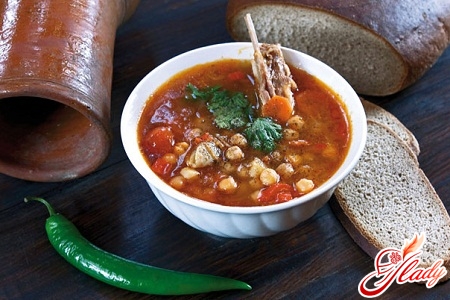
The recipe for lagman
So, lagman. The recipe is basic, variations are possible. If you are making this dish for the first time, first knead the dough for chuzma (noodles), and only then take on the vaja.
- Chuzma
Make sure there are no drafts in the room,Otherwise, the dough will tear when stretched. You need to take about one kilogram of flour, one and a half glasses of water, 3 eggs, and salt. Mix the eggs with water and salt. Gradually add flour to the resulting mixture, stirring. Knead a stiff dough. Then continue kneading the dough on the table, rolling the future noodles into a ball and kneading it with your fists. There is no need to hurry; patient kneading will definitely be rewarded, and the dough will become exactly as it should be - elastic, but pliable. In the end, make a ball out of the dough, wrap it in a clean towel and leave it to rest for about an hour or two. When the dough has settled, grease your hands with oil, cut off a little dough and roll a sausage out of the cut piece. Take the sausage in your hands and start pulling with both hands. There is no need to hurry here either; only very experienced cooks can stretch it right away. When the dough has stretched a little, fold the resulting rope into a spiral on a wide, oiled plate and take on the next portion. When all the sausages have passed the first stage of stretching, proceed to the second stretching, and if necessary, to the third. Do not forget to grease your hands with oil. Form the stretched noodles into a spiral again and leave for one or two hours. As often happens, the description often takes longer than the process itself. Do not be afraid, you will definitely get a wonderful chuzma, especially if you act slowly, enjoying the process. Some sources recommend rolling the initial sausages on the table; this will clearly make the cooking process easier, but you are unlikely to achieve the necessary lightness and elasticity of the noodles. If you do not strive to achieve this, then it is better to just buy spaghetti in the store. Boil salted water and proceed to the final part of cooking the noodles. At this stage, stretching will already become an easy and even fun task. Take the bundle with both hands, beat it a little on the table and pull. The ideal thickness of chuzma is about the same as a phone charger cable. Hang the noodle threads on a wooden stick (spoon) and gradually lower them into boiling water. Three minutes of cooking is enough for the lagman to be ready. Throw it into a colander and place it under a stream of cold water. That's it! Chuzma is ready.
- Vaja
Prepare all the ingredients in advance to avoid unnecessary fuss. Remember that lagman is an oriental dish, it requires concentration and calmness. Take 700-800 g of meat and 1.5 kg of vegetables:
- large tomatoes - 4 pcs.
- 4-5 small potatoes
- 2 sweet peppers garlic head
- the remaining volume is made with onions and carrots. (You can take other vegetables, of your choice).
Cut the meat into strips or cubes, vegetables— cubes, onion - rings or cubes. Heat the cauldron, melt the fat tail fat. Remove the cracklings. Make the fire above medium, but not too high. Fry the meat until a nice color. Then add the onion (it should turn golden!). If necessary, add water. Now it's the carrots' turn (and eggplants, if using). After lightly frying the vegetables, add finely chopped garlic, tomatoes and beans (and if needed for color, then tomato paste), bell pepper. Let the vegetables fry thoroughly. Pour boiling water or broth over the vaja, wait until it boils and reduce the heat. The amount of liquid regulates the thickness of the gravy, pour as much as you need to get the desired result. Wait 20 minutes. (This is the ideal moment to start cooking the chuzma). Has the vaja boiled away halfway? Has it become fiery red? Does its aroma fill your heart with joy and anticipation of gastronomic delight? Then season it with coriander, a little star anise, freshly ground cumin, hot pepper. Put in the potatoes and make sure they don’t overcook, otherwise the broth will become cloudy. Bring to readiness over very low heat. Skim off excess fat from the top (you don’t have to). Add seasonings — juSai or garlic shoots, black pepper. Chop and add fresh herbs: parsley, cilantro, if you can find — jambul (or basil, dill, celery). Cover tightly with a lid and let it brew for 10-15 minutes. Finally, take the kasa (have you forgotten that this is a special plate?) and be sure to scald it so that it does not disrupt the thermal integrity of the cooked lagman. If the chuzma has cooled down, do the same with it. Put the noodles in the kasu, pour the fragrant vadzha on top. If necessary, sprinkle the plate with herbs, garlic, cracklings. Serve the lagman with a fork and spoon. The fork is for the noodles, the spoon is for the vadzha. That's it. Now enjoy! Eastern housewives cook lagman at least twice a week. And they know a lot about enjoying food. Maybe you should follow their example? We recommend reading:




